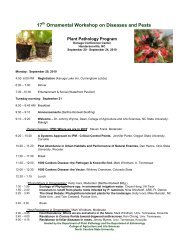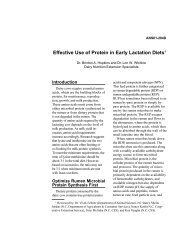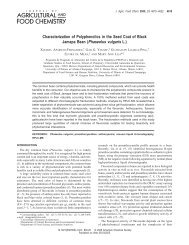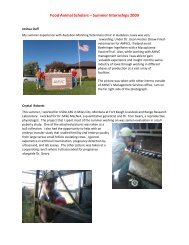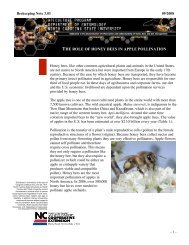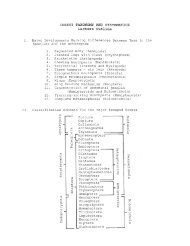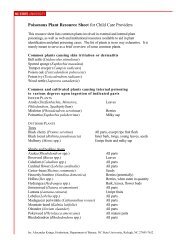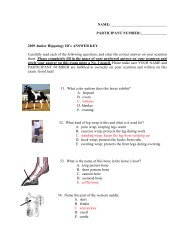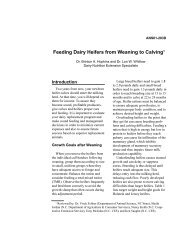Sample Sets of Oral Reasons for Livestock Judging Contests
Sample Sets of Oral Reasons for Livestock Judging Contests
Sample Sets of Oral Reasons for Livestock Judging Contests
Create successful ePaper yourself
Turn your PDF publications into a flip-book with our unique Google optimized e-Paper software.
<strong>Sample</strong> <strong>Sets</strong> <strong>of</strong> <strong>Oral</strong> <strong>Reasons</strong> <strong>for</strong><br />
<strong>Livestock</strong> <strong>Judging</strong> <strong>Contests</strong><br />
by <strong>for</strong>mer members <strong>of</strong> Texas A&M University <strong>Livestock</strong> <strong>Judging</strong> Teams<br />
MARKET STEER SAMPLE REASONS by Chapel Schuessler<br />
ASWeb-038<br />
6-00<br />
“I placed this class <strong>of</strong> market steers 2-1-4-3. I initiated the class with 2, as he was the most complete steer in terms<br />
<strong>of</strong> growth, leanness, and muscularity. If I could change my class winner, I would like to see him thicker and fuller<br />
through his lower quarter. Nonetheless, in my top pair <strong>of</strong> more packer acceptable black steers, it’s 2 over 1 as he is<br />
leaner. He is trimmer through his brisket and flank region and handles leaner over his 12 th and 13 th rib. Also, he<br />
exhibits a thicker and more expressive top. He’s a larger outlined, longer cleaner fronted calf who is longer from<br />
hooks to pins. He certainly would take to the rail a carcass that was trimmer designed and higher cutability.<br />
I grant that 1 showed the most volume and dimension through his lower quarter. He was a wider based steer who<br />
was mellower handling. But after this, he was a shorter, coarser fronted calf who was wastier through his lower 1/3,<br />
so he is second.<br />
Even so, in my middle pair it’s easily 1 over 4 as he was simply heavier muscled. He showed more thickness, shape and<br />
dimension down his top; he was wider and more powerful out <strong>of</strong> his hip; and he maintained this advantage through<br />
his lower quarter. He was a wider chested, deeper ribbed, boulder sprung, higher volumed calf who was stouter<br />
designed and more correctly conditioned. Carcass wise, he should produce more total pounds <strong>of</strong> a high quality<br />
product.<br />
I realize the Shorthorn appearing calf was the leanest in the class. But, un<strong>for</strong>tunately, he also was the harshest<br />
handling, narrowest chested and flattest ribbed, so he is third.<br />
Moving to my bottom pair <strong>of</strong> contasting types, cutability places 4 over 3 as he was leaner. He handled leaner from<br />
his <strong>for</strong>e to rear rib and was trimmer through his cod. He would certainly rail a carcass with a lower numerical yield<br />
grade. Additionally, he’s a thicker topped calf who ties in smoother through his neck shoulder junction, he’s leveler<br />
down his top and squarer out <strong>of</strong> his hip.<br />
I recognize the fact that the Here<strong>for</strong>d appearing calf was heavier conditioned and deeper ribbed. But he was the<br />
fattest, wastiest fronted calf who was easy in his top. Quite simply, he would take to the rail the fattest, lowest<br />
cutability carcass, so he’s last.<br />
PERFORMANCE BULLS SAMPLE REASONS by Chris Boleman.<br />
I placed the per<strong>for</strong>mance Limousin bulls 2-4-3-1. The scenario dictates a growthy, heavy muscled bull. Thus, 2 sorts to<br />
the top <strong>of</strong> the class. 2 is the heaviest muscled, most durably designed and most capacious bull. Ideally, I would like to<br />
see him smoother out <strong>of</strong> his shoulder. Nonetheless, in my top pair <strong>of</strong> higher per<strong>for</strong>ming red bulls, it is 2 over 4. 2 is<br />
a deeper ribbed, more capacious bull. But most importantly, he is heavier muscled bull that shows more shape and<br />
expression down his top, is wider at his stifle, and ties this advantage to a thicker quarter. In addition, he is the<br />
highest in his growth EPDs. Due to his advantages in growth and muscularity, he should sire <strong>of</strong>fspring demanding the<br />
greatest premium when sold on a grade and yield basis.<br />
Yes, 4 is a larger framed, longer sided, longer hipped bull that is more structurally correct and <strong>of</strong>fers greater longevity<br />
in the breeding herd. But, after this, he is flat ribbed and narrow gauged, so he is second.
Nonetheless, in my middle decision, it is 4 over 3. 4 is a larger framed, longer bodied, growthier bull that <strong>of</strong>fers more<br />
length and extension when viewed from the side. Coupled with the fact that he is higher in his growth EPDs, he<br />
should sire <strong>of</strong>fspring that reach slaughter weight at an earlier age.<br />
I do reailze that 3 is a leaner, heavier muscled bull that should produce <strong>of</strong>fspring excelling in cutability, but at the same<br />
time, 3 is round in his muscle pattern, coarse in his shoulder, and small in his frame so he is third.<br />
Moving to my bottom decision <strong>of</strong> lower per<strong>for</strong>ming black bulls, it is 3 over 1. Quite simply, there is more bull there.<br />
He is a heavier muscled, larger framed, growthier bull that has more body capacity. He opens with more width to his<br />
chest as well as more depth and spring <strong>of</strong> rib.<br />
Yes, 1 is the leanest in his backfat EPD, but after this, he is the smallest, lightest muscled, shallowest bodied bull <strong>of</strong> the<br />
four. Quite simply, he is the least scenario adaptable bull in this class.<br />
CROSSBRED MARKET HOGS SAMPLE REASONS by Dalton Nix<br />
I placed the crossbred market hogs 1,4,2, and 3. I started with the most powerfully muscled barrow that combined<br />
leanness and structural correctness to the highest degree. No, he wasn’t the largest scaled and I’d like to see him<br />
leveler hipped, nonetheless, in the top pair <strong>of</strong> more product oriented, blue rumped barrows, it’s 1 over 4. 1 was the<br />
most expressively muscled. He displayed a distinct groove down his top and dimple above his tailhead. Plus he<br />
exhibited more bulge and thickness to the center and lower portions <strong>of</strong> his ham. This, coupled with the fact that he<br />
was cleaner in his elbow pockets and leaner over the turn <strong>of</strong> his loinedge, should lead to the most shapely, muscular<br />
carcass with the highest % lean. Finally, he was more structurally sound, as he stepped out with more flex and give to<br />
his hip, hocks, and pasterns allowing him to move with a more fluid stride.<br />
I realize 4 is larger outlined, pounds heavier, and higher volumed; but at the same time he’s pushing more fat in his<br />
shoulder pockets, he’s short framed, tight hipped, and more restricted in his movement. So he’s second.<br />
Even so, in the middle pair it’s 4 over 2. 4 was a more carcass oriented barrow that was wider in his skeletal design.<br />
He opened up wider through his chest floor, stepped out on a bigger, bolder blade and spread more thickness and<br />
dimension <strong>of</strong> muscling down his top. Plus, he came out squarer and wider at his hip, where he exhibited more volume<br />
and expression <strong>of</strong> muscling to all portions <strong>of</strong> his ham. Finally, due to his advantages in muscling, he should demand a<br />
premium if marketed on a grade and yield basis.<br />
I readily admit 2 was longer fronted and looser structured, but I faulted the floppy-eared barrow and left him third as<br />
he was lighter muscled, narrower designed, toed out on his front end, and was weak in his pasterns.<br />
Despite this, in the final comparison I used 2 over 3. 2 was more durable constructed and wider centered. He<br />
exhibited more shape and thickness down his top, was squarer rumped, and attained this advantage to thicker more<br />
expressively muscled lower ham. Along with this, he tracked out wider and squarer on both ends and should yield a<br />
carcass with more pounds <strong>of</strong> merchandisable product.<br />
I concede 3 was the nicest balanced, longest sided, and levelest designed in the class; but this simply doesn’t<br />
compensate <strong>for</strong> the fact that the white hog was the lightest muscled and the narrowest designed. He tapered<br />
through his hip and was flat though his lower ham. Quite simply, he should <strong>of</strong>fer the least muscular carcass in the<br />
class.<br />
SUFFOLK EWES SAMPLE REASONS<br />
I placed this class <strong>of</strong> Suffolk ewes 4-2-1-3. I started <strong>of</strong>f the class with 4 as she best combined frame, capacity, and<br />
breed character. Ideally, I would have liked to have seen my class winner stronger on her pasterns and straighter on<br />
her front feet as she was splay footed. Nonetheless, I still preferred 4 over 2 in my initial placing as she was an<br />
especially larger framed ewe that stood in more length <strong>of</strong> cannon. 4 was also a higher volumed ewe that was deeper<br />
and bolder sprung about her rib. Finally, she had the best Suffolk head in the class as she was blacker at her points<br />
and had a more bell-shaped ear.
I will admit that 2 was more feminine through her front end as she was longer necked and she blended more<br />
smoothly through her shoulder. However, I fault her as she was bow-legged on her rear legs and was the lightest<br />
muscled ewe <strong>of</strong> the class.<br />
In my middle decision it’s still 2 over 1 as she was a more feminine ewe that was longer necked and was laid in flatter<br />
and smoother through the shoulder. She was a more symmetrical ewe that blended more smoothly from front to<br />
rear. Finally, and most importantly, 2 was more correct being stronger racked and leveler docked.<br />
There is no doubt that 1 was blacker at the base <strong>of</strong> her ear, she too was heavier muscled being thicker through her<br />
center and lower leg but she stays 3 rd as she was weak topped, droopy docked, and restricted in her movement <strong>of</strong>f<br />
her rear legs.<br />
In my final pair, I preferred 1 over 3 as she was simply larger framed and more extended, and exhibited more<br />
potential <strong>for</strong> future growth and outcome. Additionally, 1 was a higher quality ewe that was more feminine about her<br />
head.<br />
I will grant that 3 is a higher volumed ewe in proportion to her body size being especially bolder ribbed, furthermore<br />
she is heavier muscle having width down her top and more volume to her leg, but that simply does not compensate<br />
<strong>for</strong> the fact that she has the poorest breed character being brown on her legs and on her poll, and is the least<br />
feminine, smallest framed, and earliest maturing ewe in the class.<br />
MARKET LAMBS SAMPLE REASONS<br />
I aligned the market lambs 4-3-2-1. I started the class with 4 as he best combined muscle, leanness and balance to the<br />
greatest degree. NO, my class winner wasn’t the biggest statured nor was he the longest hindsaddled lamb in the<br />
class. Nevertheless, in my initial decision it’s 4 over 3. 4 was a nicer balanced, more structurally correct lamb as he<br />
was smoother shouldered, stronger topped, leveler docked, and stood straighter and squarer on his feet and legs. In<br />
addition, 4 was heavier muscled as he displayed more volume to his <strong>for</strong>earm, more thickness to his top and met my<br />
hands with a fuller, plumper leg. He too was trimmer patterned and lighter conditioned as he handled with more<br />
distinction down his top with less cover over his <strong>for</strong>e and rear rib and was cleaner about his breast and lower onethird.<br />
Finally, due to his advantages <strong>of</strong> muscle and trimness, 4 should go to the rail with a superior cutability. Now, I<br />
admit that 3 was a bigger framed lamb that was longer loined, but at the same time he was narrow made, light<br />
muscled, and handled with a greater degree <strong>of</strong> finish that did my class winner.<br />
Nevertheless, in my middle comparison it’s 3 over 2. 3 was a bigger, growthier, pounds heavy lamb that exhibited<br />
more apparent weight per day <strong>of</strong> age. HE too was a bigger statured more extended lamb that was especially more<br />
elongated from his last rib back. Moreover, 3 was a bigger volumed lamb that was wider through his chest floor and<br />
exhibited more dimension to his rib as he was deeper bodied. Finally, due to his advantages <strong>of</strong> size and scale, he<br />
should go to the rail with more total pounds <strong>of</strong> merchandisable product.<br />
Now, I concede that the ewe lamb was more expressive in her muscle and lighter conditioned, but at the same time<br />
she was small framed and pounds light in relation to my top pair.<br />
Finally, in my concluding decision it’s 2 over 1. The ewe lamb was much heavier muscled as she handled with more<br />
volume to her <strong>for</strong>earm, more thickness and dimension to her rack and loin and more volume and expression to her<br />
center and lower leg. Furthermore, 2 was lighter conditioned as she handled with less cover down her top, over her<br />
rib and was cleaner about her breast. Finally, due to 2’s muscle advantages, she should go to the rail with a more<br />
shapely carcass. Now, I realize that the black lamb was bigger framed and longer loined. But that simply doesn’t<br />
compensate <strong>for</strong> the fact that 1 was narrow made, light muscled and heavy conditioned. Quite simply 1 would go to<br />
the rail with the poorest cutability, least valued carcass in the class.<br />
Produced by the TAMU Department <strong>of</strong> Animal Science, The Texas A&M University System<br />
Additional in<strong>for</strong>mation on animal science topics and junior beef cattle in<strong>for</strong>mation can be found<br />
on the Web at http://animalscience.tamu.edu.<br />
Extension publications can be found on the Web at: http://tcebookstore.org<br />
Visit Texas Cooperative Extension at: http://texasextension.tamu.edu<br />
Educational programs <strong>of</strong> Texas Cooperative Extension are open to all people without regard to race, color, sex, disability, religion, age or national<br />
origin. Issued in furtherance <strong>of</strong> Cooperative Extension Work in Agriculture and Home Economics, Acts <strong>of</strong> Congress <strong>of</strong> May 8, 1914, as amended, and<br />
June 30, 1914, in cooperation with the United States Department <strong>of</strong> Agriculture. Chester P. Fehlis, Director, Texas Cooperative Extension, The Texas<br />
A&M University System.



